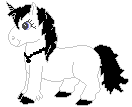

A fabled beast having the head and legs of a horse and a long, twisted horn set in the middle of its forehead. Pure white, it has been used as a symbol of virginity, holiness and chastity. It has also been described as a white horse, with the legs of an antelope, and a spirally grooved horn projecting forward from the center of its forehead, with the horn being white at the base, black in the middle, and red at the tip. The earliest reference to the unicorn is found in the writings of the Greek, Ctesias. Ctesias returned from Persia about the year 398 BC and wrote a book on the marvels of the Far East. He told of a certain wild ass in India with a white body and a horn on the forehead. The dust filed from this horn, he said, was a protection against deadly drugs. Ancient mythology contains stories of unicorns where the horn was supposed to contain a liquid that would cure disease, but the animal was very swift and hard to catch. It was once considered native to India, though it was reportedly seen throughout the world.
The "Ch'i-lin" is the Chinese Unicorn. An odd-looking creature, it was regarded as a sign of good fortune and justice. It was said to be able to see the evil in men's hearts and slay the wicked with its single horn. It's body and head were similar to a deer's; it had hooves like a horse; a tail like an ox; and a single backward-curving, fleshy horn. Accounts vary as to whether it was a shiny, scaly-skinned creature whose scales refracted the many colors around it or whether it just had multi-coloured hair. Some stories feature them as horses that could run as fast as the speed of light; other stories portray them as being able to walk on grass without crushing it; and several stories point to their ability to sense the guilty. The Japanese "Ki-rin" is strongly based on the Ch'i-lin. | More Mythology | Home |Unicorn -

